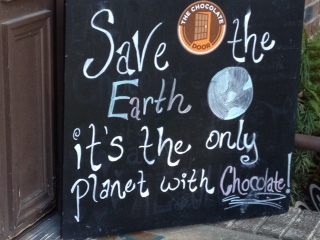 There are few things people take more seriously in their personal lives than chocolate. I realize you think I am being facetious, but think about your childhood, think about Christmas, think about your pregnancy or your wife’s pregnancy or getting dumped or getting promoted or your birthdays or retirement parties. Think about them and then think of a flavor.
There are few things people take more seriously in their personal lives than chocolate. I realize you think I am being facetious, but think about your childhood, think about Christmas, think about your pregnancy or your wife’s pregnancy or getting dumped or getting promoted or your birthdays or retirement parties. Think about them and then think of a flavor.
If you say vanilla, you might as well just throw yourself off a bridge right now – what are you, a maniac?? Of course, it is chocolate you must be thinking of.
Chocolate, the flavor of all rewards. One of the few all-ages legal narcotics that is reportedly good for you. The only food that I would ever go into battle for. Chocolate is amazing. Chocolate is wonderful. And I am certainly not the only one to think so.
When the very American cheese company Kraft, attempted a hostile takeover of the very British chocolate company, Cadbury, the heiress and great-granddaughter of the company’s creator was heard to exclaim in horror “I can’t accept that Cadbury has gone to America. To a plastic cheese company!!!”
Though I feel (and others agree) that Cadbury’s is not real chocolate, but rather a variety of pond scum, I appreciate Cadbury junior’s sentiment — Give me Hershey’s or give me death!!
Chocolate is regional. Chocolate is beloved. And I absolutely support her decision to sell her 30 million pound home to launch her own British chocolate franchise. I would certainly sell my home, car and grapefruit tree (I do live in California after all) to preserve a beloved chocolate company.
Of course, that is if chocolate were to stay as wonderful in the future as it is today. Now you have no doubt already heard a million times that chocolate yield, like other food items, is at risk from the extreme weather events—drought and giant storms—that can come with climate change (3, 5). This is of course bad for chocolate consumers, chocolate makers and cocoa growers (probably the worst for cocoa growers, really). But being a picky chocolate consumer means not just being interested in how much chocolate you can shove down your throat (usually a gallon a day is my limit), but rather the quality of that chocolate.
 When thinking about quality, you need to think about two chemical components: polyphenolics (poly=lots, phenol=carbon-dominated rings) and alkaloids (nitrogen containing compound) (2, 4). In cocoa, polyphenolics and alkaloids are considered flavor precursors – i.e. necessary to create the chocolate flavors during the fermentation process (yes, they ferment chocolate – awesome!) (1).
When thinking about quality, you need to think about two chemical components: polyphenolics (poly=lots, phenol=carbon-dominated rings) and alkaloids (nitrogen containing compound) (2, 4). In cocoa, polyphenolics and alkaloids are considered flavor precursors – i.e. necessary to create the chocolate flavors during the fermentation process (yes, they ferment chocolate – awesome!) (1).
You’ve heard me talk about the importance of phenolics and alkaloids before in my blogs about wine, tea, cocaine and tobacco. These compounds are used by the plant to ward off predators, but fortunately for us they also create amazing flavors – what kills the grasshopper, delights the Minda.
Even though these compounds are important to flavor, there is little information on the effect of climate on them. So this leaves us to play the scientist and start generating hypotheses (putting on nerd glasses). We know from my tea blog that temperature can influence the level of phenolic compounds in plants, but it depends on the plant, the phenolic and the temperature level. Well, that doesn’t help….what about alkaloids?
We know from my tobacco blog that increased carbon dioxide reduces the concentration of nicotine (an alkaloid) in tobacco plants, and alkaloids in general are reduced in cocaine-makin’ coca plants (that’s coca, not cocoa) by increased temperature. So could we hypothesize that alkaloid concentrations will go down in a warmer and more carbon-rich environment resulting in a less bitter chocolate?
Perhaps, but perhaps not! We know from my blog on hallucinogens that alkaloid content in datura plants varies with age, temperature and carbon dioxide. So it sounds like plants actually differ quite a bit from each other, and making vast generalizations from one species to another may not give us the answers we are looking for.
It seems that if we want to ensure that our grandchildren enjoy Hershey’s kisses as much as we do, far more research will need to be done. When does Nestle start handing out grants?
Though we don’t know what effect climate change will have on chocolate flavors, we do know that extreme weather events will negatively impact the amount of cocoa on the market place. This fact alone has me planning a chocolate bunker in my basement as I write this.
Now I’d never ask you to sell your own home to save chocolate as the heiress to the Cadbury fortune did, but could I convince you to sell your SUV to reduce your greenhouse gas emissions? Every little bit helps, and when it comes to chocolate, isn’t it worth it?
Minda has a PhD in Biology from Tufts University and is a science writer in the Bay area. She was fascinated to learn about the different “odor qualities” experts associate with cocoa. In addition to the expected earthy, buttery and biscuit-like, there is also sweaty, grassy, cooked-meat, potato-chip, mothball and rancid. Who’s hungry?
(1) Flavor Formation and Character in Cocoa and Chocolate: A Critical Review
(2) Cocoa has more phenolic phytochemicals and a higher antioxidant capacity than teas and red wine
(3) Response of cocoa trees (Theobroma cacao) to a 13-month desiccation period in Sulawesi, Indonesia
(4) Chocolate and red wine – A comparison between flavonoids content
(5) Effect of climate change on cocoa yield: a case of cocoa research Institute (crin) farm, oluyole local government ibadan oyo state